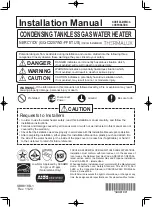
lp-672 Rev. 000 Rel. 002 Date 10.3.18
38
C. Additional Precaution for Excess Flow Valve (EFV)
If an excess flow valve (EFV) is in the gas line, check the manufacturer’s
minimum and maximum flow capacity ratings. An improperly sized
EFV will not allow for a full flow of gas to the water heater and will
cause the water heater to malfunction. See Figure 41.
Figure 41 - Excess Flow Valve (EFV)
D. Checking Gas Pressure at the Water Heater for Proper
Operation
NOTE:
Refer to Figure 42 when checking gas pressure. Loosen the
bolts before checking the gas inlet pressure.
1. The water heater and its individual shutoff valve must be
disconnected from the gas supply piping system during any
pressure testing of the system at test pressures greater than ½ psi
(3.5 kPa).
2. The water heater must be isolated from the gas supply piping
system by closing its individual manual shutoff valve during any
pressure testing of the gas supply piping system at test pressures
equal to or less than ½ psi (3.5 kPa).
The minimum and maximum inlet gas line pressures must meet the
requirements shown in Table 19.
Natural or LP Gas
Minimum Pressure
3.5” WC
Maximum Pressure
14”WC
Table 19 - Gas Pressure Requirements
Do not fire (operate) the water heater until all connections have
been completed and the heat exchanger is filled with water. Doing
so will damage the water heater and void the warranty.
Figure 42 - Gas Valve Detail
E. Setting and Verifying the Combustion Setting
1. After the water heater has fired, flip DIP switch seven (7) to the
ON position (low fire). Proceed to check heater combustion values.
NOTE:
Use a combustion analyzer to ensure CO and CO2 values are
within the range shown in Table 20.
It is required to use a combustion analyzer to verify final adjustment
according to the combustion chart (Table 20). Failure to do so could
result in serious personal injury or death.
If the readings obtained are lower or higher than the combustion
readings in Table 20, use a T15 Torx screwdriver to adjust the offset
screw in a clockwise (positive) or counterclockwise (negative) direction
(approximately 1/4 turn). See Figure 42. Check your combustion values.
Repeat this procedure until the values obtained on the combustion
analyzer agree with those stated in Table 20.
NOTE:
If the heater makes a whistling sound (harmonics) at low fire,
adjust the offset screw in a clockwise (positive) direction (approximately
1/8 turn). Check your combustion values and ensure they agree with
those stated in Table 20 before proceeding.
It is very important that the combustion system be set within the
recommended CO measurements listed in Table 20. Visually looking
at the burner does not determine combustion quality. Failure to
measure combustion with a Combustion Analyzer and set the
throttle within the recommended CO measurements could result in
property damage, severe personal injury, or death.
Natural Gas
LP Gas
Fan Speed
Low
High
Low
High
CO PPM
<175
<175
CO
2
(%)
8 - 9 1/2
8 1/2 - 10
9 - 10 1/2
9 1/2 - 11
Table 20 - Combustion Settings
2. When low fire settings have been obtained, flip DIP switch seven
(7) to its original (OFF) position. This will return the heater to normal
operation.
3. Flip DIP switch six (6) to ON (high fire). Again check combustion
readings with a combustion analyzer.
NOTE:
DO NOT adjust the gas valve offset screw at high fire. The offset
screw is only used to adjust combustion values at low fire.
4. When complete, flip DIP switch six (6) to its original (OFF) position.
This will return the heater to normal operation.
5. Allow heater to operate normally. Ensure it is operating properly.
6. Reinstall the heater front cover.
7. Use a Phillips Head screwdriver to reinstall the heater top cover.
















































